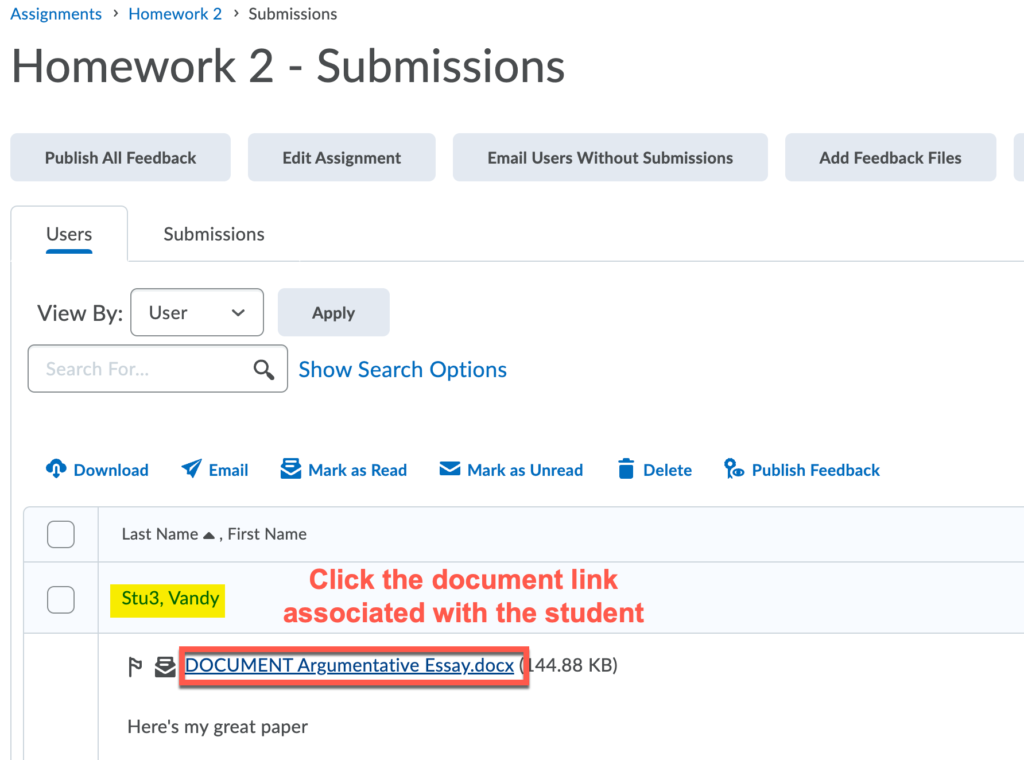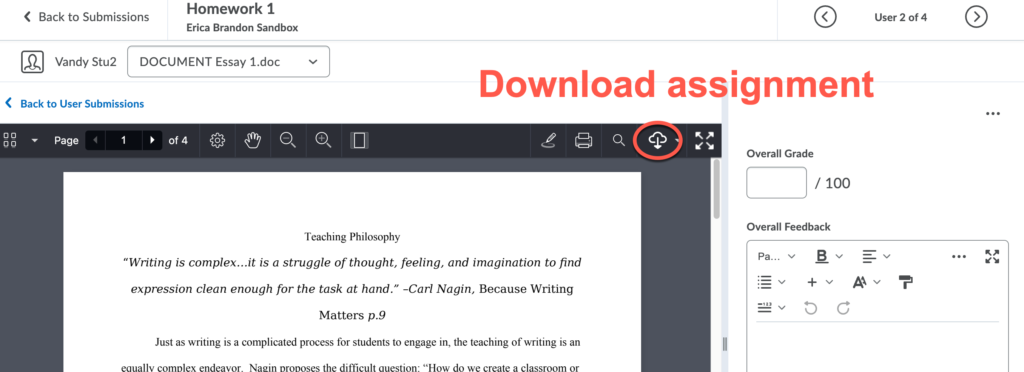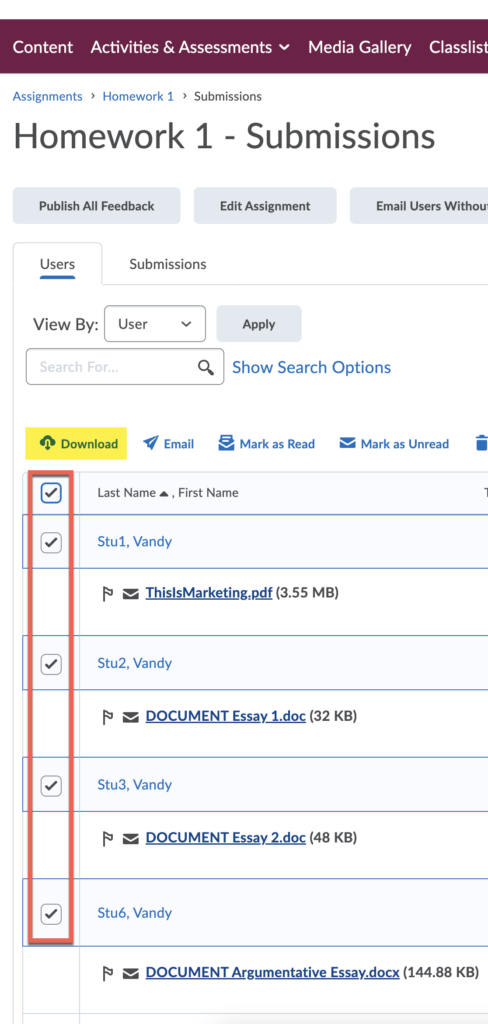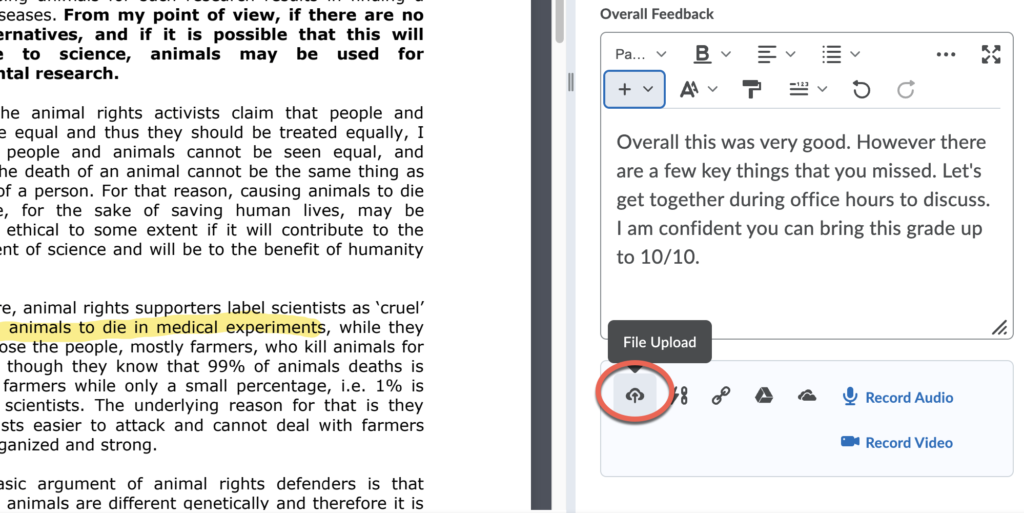Grading an Assignment
The Assignment tool provides instructors with a variety of tools to help grade assignments and to leave feedback. All of this is done on the Assignment evaluation page. You are also able to attach a rubric to the assignment, provided you have created one in Brightspace. Click here for our guide on creating rubrics.
The most convenient way to grade assignments, is on the Evaluation page. Another option is to download the assignments to your computer and grade them in Microsoft Word. You can also use TurnitIn, which is an application built into Brightspace. TurnitIn offers a “Similarity Check” to alert you of any possible plagiarism, and also offers annotation tools.
Access the Assignment Evaluation page
- Go to Assignments. Click the dropdown menu by the desired assignment, and select View Submissions.

- From the list of students who have submitted a file, click on one of the submitted files.

This takes you to the evaluation page. Here you have many options for assessment and providing feedback. Also see the image below.
- By clicking on the document, you can use the built in Annotation Tool. Click here for more information on how to use annotations.
On the right hand side you will see the feedback panel. This panel will allow you to privately communicate FERPA-sensitive grade information with your student. You can:
- Attach and use a rubric. Click to expand the rubric and grade by criterion.
- Assign a grade. Enter manually, or if you are using an rubric this is automatic entered.
- Add text. Add images and other things with the insert stuff button in the feedback text box.
- Upload a feedback file. This can be a graded copy of the submission, instructor notes, or another file.
- Add video or audio feedback. This feature is useful when you want to communicate more personally with your students or accurately convey tone. You can record one minute of audio or three minutes of video.
After leaving feedback and assigning a grade, you can publish feedback immediately or save your feedback as a draft and release it at a later time. This enables you to revise and review evaluations and publish your feedback to multiple users at the same time. You also have the option to retract published feedback if you want to provide an update to past evaluations but only want learners to access your most recent feedback.
Download assignment files
You can download a student’s file submission from the Evaluation page:
It is also possible to download all user submissions in a .zip file, leave feedback within the files using the Word or PDF track changes and comment features, then upload the files back to the appropriate assignment submission folder so they appear as attachments.
- To download all student work from the Assignment View Submissions page, click the box next to each student’s name, or check the box at the top of the column that will check every student. Then click Download.

- Open the Zip file that is downloaded to your computer. Enter feedback one by one, save and close the files. Do not rename the files.
- To return feedback on all downloaded submissions at once, click Add Feedback Files. Upload your compressed .zip file using the same format that it was downloaded with, then click Add.
To add the file to students one at a time, go to the Evaluation page for that student. Use the File Upload button underneath the feedback text box
Use Turnitin
Turnitin is an originality checker (sometimes also called a plagiarism detector, although that term stretches what the tool is actually capable of). However, it is possible NOT to use the originality tools, and instead use Turnitin’s robust grading and evaluation tools which include rubrics, Quickmarks, and an e-rater that assigns student essays with typical feedback for surface-level writing issues that is then fully editable by the instructor. Here are our guides for using Turnitin:
- Video Introduction to TurnitIn’s Quickmarks
- How do I enable TurnitIn on a new assignment?
- How do I enable TurnitIn on an existing assignment?
- An Overview of TurnitIn Feedback Studio
- How to use the similarity report tools in TurnitIn
- How to provide feedback using TurnitIn
- How to manually enter grades using TurnitIn
- How do I use a rubric in the TurnitIn Feedback Studio


